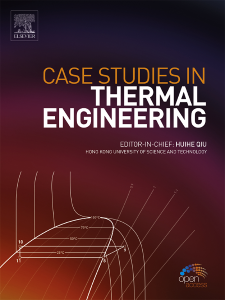倾斜隧道火灾中浮力通量的非对称分布及其对烟雾传播速度和背层长度的影响
IF 6.4
2区 工程技术
Q1 THERMODYNAMICS
引用次数: 0
摘要
倾斜隧道在现代社会中十分常见。与水平隧道火灾相比,倾斜隧道火灾中的烟雾运动表现出明显的不对称性。本研究进行了一系列数值模拟,以研究源浮力通量的非对称分布及其对倾斜隧道火灾中烟雾移动的影响。由于浮力和烟囱效应,向上部入口推进的烟气浮力通量比例 η 随时间变化。当火灾烟流撞击隧道顶板时,浮力通量出现初始分布,η 值由隧道倾角 α 决定。η随时间的增长轨迹也受α控制,但稳态值取决于α和着火位置。我们建立了模型来计算不同阶段的 η。η值会影响烟流特性。烟雾传播速度与单位宽度浮力通量的立方根成比例,而浮力通量可根据 η 得出。此外,背层长度随 η 的稳态值增加而增加。这些发现有助于更好地理解倾斜隧道火灾中的烟流机制。本文章由计算机程序翻译,如有差异,请以英文原文为准。
Asymmetrical distribution of buoyancy flux and its effect on smoke propagation velocity and backlayering length in inclined tunnel fires
Inclined tunnels are commonly seen in modern society. Compared with horizontal tunnel fires, smoke movement in inclined tunnel fires exhibits noticeable asymmetry. In this study, a series of numerical simulations are conducted to investigate the asymmetrical distribution of source buoyancy flux and its impact on smoke movement in inclined tunnel fires. Because of buoyancy and the stack effect, the proportion of the buoyancy flux of the smoke advancing towards the upper portal, , varies with time. When the fire plume impinges the tunnel ceiling, there is an initial distribution of buoyancy flux and the value of is determined by tunnel inclination angle . Subsequently, gradually increases until the steady state is achieved. The growth trajectory of with time is also controlled by , but the steady-state value is dependent on both and the fire location. Models are established to calculate in different stages. The value of influences smoke flow characteristics. Smoke propagation velocity scales with the cubic root of buoyancy flux per unit width, which can be derived based on . Additionally, the backlayering length increases with the steady-state value of . The findings contribute to a better understanding of the mechanisms governing the smoke flow in inclined tunnel fires.
求助全文
通过发布文献求助,成功后即可免费获取论文全文。
去求助
来源期刊

Case Studies in Thermal Engineering
Chemical Engineering-Fluid Flow and Transfer Processes
CiteScore
8.60
自引率
11.80%
发文量
812
审稿时长
76 days
期刊介绍:
Case Studies in Thermal Engineering provides a forum for the rapid publication of short, structured Case Studies in Thermal Engineering and related Short Communications. It provides an essential compendium of case studies for researchers and practitioners in the field of thermal engineering and others who are interested in aspects of thermal engineering cases that could affect other engineering processes. The journal not only publishes new and novel case studies, but also provides a forum for the publication of high quality descriptions of classic thermal engineering problems. The scope of the journal includes case studies of thermal engineering problems in components, devices and systems using existing experimental and numerical techniques in the areas of mechanical, aerospace, chemical, medical, thermal management for electronics, heat exchangers, regeneration, solar thermal energy, thermal storage, building energy conservation, and power generation. Case studies of thermal problems in other areas will also be considered.
 求助内容:
求助内容: 应助结果提醒方式:
应助结果提醒方式:


